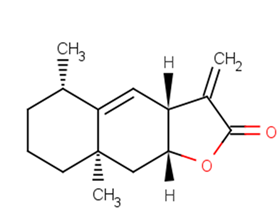
Helenine
CAS No. 546-43-0
Helenine( Alantolactone | NSC 302289 | NSC302289 )
Catalog No. M18777 CAS No. 546-43-0
Alantolactone(Alant camphor), a sesquiterpene lactone, has potential activity against triple-negative breast Y MDA-MB-231 cells by suppressing the signal transducer and activator of transcription 3 (STAT3) signaling pathway.
Purity : >98% (HPLC)
 COA
COA
 Datasheet
Datasheet
 HNMR
HNMR
 HPLC
HPLC
 MSDS
MSDS
 Handing Instructions
Handing Instructions
| Size | Price / USD | Stock | Quantity |
| 5MG | 45 | In Stock |


|
| 10MG | 59 | In Stock |


|
| 25MG | 130 | In Stock |


|
| 50MG | 210 | In Stock |


|
| 100MG | 378 | In Stock |


|
| 200MG | Get Quote | In Stock |


|
| 500MG | Get Quote | In Stock |


|
| 1G | Get Quote | In Stock |


|
Biological Information
-
Product NameHelenine
-
NoteResearch use only, not for human use.
-
Brief DescriptionAlantolactone(Alant camphor), a sesquiterpene lactone, has potential activity against triple-negative breast Y MDA-MB-231 cells by suppressing the signal transducer and activator of transcription 3 (STAT3) signaling pathway.
-
DescriptionAlantolactone neuroprotective roles in traumatic brain injury via anti-inflammatory, anti-oxidative and anti-apoptosis pathways.(In Vitro):Alantolactone induces apoptosis in HepG2 cells in a dose-dependent manner. This Alantolactone-induced apoptosis is found to be associated with GSH depletion, inhibition of STAT3 activation, ROS generation, mitochondrial transmembrane potential dissipation, and increased Bax/Bcl-2 ratio and caspase-3 activation. Alantolactone decreases STAT3 translocation to the nucleus, its DNA-binding, and STAT3 target gene expression. Alantolactone significantly inhibits STAT3 activation with a marginal effect on MAPKs and on NF-κB transcription; however, this effect is not mediated by inhibiting STAT3 upstream kinases.Alantolactone induces activin/SMAD3 signaling in human colon adenocarcinoma HCT-8 cells. Alantolactone performs its antitumor effect by interrupting the interaction between Cripto-1 and the activin receptor type IIA in the activin signaling pathway.Alantolactone (5 μg/mL, 24 h) inhibits cell proliferation in colon adenocarcinoma HCT-8 cells. (In Vivo):It is found that the average tumor volume in the Alantolactone-treated mice is approximately 2.17-fold lower compared with that in the control mice. However the administration of Alantolactone does not affect the overall bodyweight during the experimental period, suggesting no apparent toxicity. Additionally, the average tumor weight is significantly lower in the Alantolactone-treated mice compared with the control mice. What’s more, the administration of Alantolactone results in a significant decrease in p-STAT3 and cyclin D1 expression in the tumor tissues.
-
In Vitro——
-
In VivoAnimal Model:Female athymic BALB/c nude mice at the age of 6 weeks.Dosage:2.5 mg/kg.Administration:I.P. injection every 2 days.Result:Exhibited anti-cancer activity.
-
SynonymsAlantolactone | NSC 302289 | NSC302289
-
PathwayOthers
-
TargetOther Targets
-
RecptorOthers
-
Research AreaCancer
-
Indication——
Chemical Information
-
CAS Number546-43-0
-
Formula Weight232.33
-
Molecular FormulaC15H20O2
-
Purity>98% (HPLC)
-
SolubilityDMSO : ≥ 100 mg/mL; 430.44 mM
-
SMILES[C@@H]1(CCC[C@]2(C1=C[C@H]1[C@@H](C2)OC(=O)C1=C)C)C
-
Chemical Name4alphaH-Eudesma-5,11(13)-dien-12-oic acid, 8beta-hydroxy-, gamma-lactone (8CI)
Shipping & Storage Information
-
Storage(-20℃)
-
ShippingWith Ice Pack
-
Stability≥ 2 years
Reference
1. Shope RE. J Exp Med. 1966 Feb 1;123(2):213-27.
molnova catalog



related products
-
19-Oxocinobufagin
19-Oxocinobufagin is a natural product from Bufo bufo gargarizans Cantor.
-
3,3-Tetramethylenegl...
Compound Fr14035 is a useful organic compound for research related to life sciences.
-
Pepinemab
Pepinemab(VX 15/2503) is a humanized IgG4 monoclonal antibody targeting sematone 4D.



 Cart
Cart
 sales@molnova.com
sales@molnova.com


